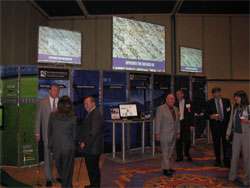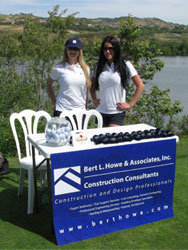Home insurance perks for green-friendly design (guest post)
February 04, 2014 —
Melissa Dewey Brumback – Construction Law in North CarolinaWondering how to get your residential clients to pony up more money for green design? Check out today’s guest post by Carrie Van Brunt-Wiley and Katherine Wood. They are writers for the Homeowners’ Insurance Blog, which serves as a resource center for insurance consumers and homebuyers across the country.
The U.S. Green Building Council’s new LEEDv4 standards present challenges for contractors, engineers, and architects – the restrictions in many cases are more stringent. There is, however an added bonus to remaining on the sustainable-building track: it’s more marketable than you think.
That’s because green homes don’t just appeal to buyers with environmental concerns any more. Now smart budgeters seek them out as well. Why? While it’s true that sustainable construction can cost about 2% more than conventional methods, McGraw-Hill’s Smart Market Report says it typically increases a building’s overall value by an average of 7.5% and improves the return on investment by 6.6%.
Read the court decisionRead the full story...Reprinted courtesy of
Melissa Dewey Brumback, Construction Law in North CarolinaMs. Brumback can be contacted at
mbrumback@rl-law.com
Contract’s Definition of “Substantial Completion” Does Not Apply to Third Party for Purposes of SOL, Holds Court of Appeal
June 15, 2020 —
Garret Murai - California Construction Law BlogThose of you in the construction industry know that the two primary statutes of limitation are the 4-year year statute of limitations for patent defects and 10-year statute of limitations for latent defects. Both statutes begin to run on “substantial completion.”
In Hensel Phelps Construction Co. v. Superior Court of San Diego, Case No. D076264 (January 22, 2020), the 4th District Court of Appeal examined whether the term “substantial completion,” as used in Civil Code section 941, which applies to residential construction, can be defined by the parties’ contract and applied to third-parties.
The Hensel Phelps Case
Hensel Phelps Construction Co. entered into a prime construction contract with the owner and developer of a mixed-use project in San Diego. Hensel Phelps was the general contractor on the project. The project included a residential condominium tower which would eventually be managed and maintained by Smart Corner Owners Association. Smart Corners was not a party to the contract.
Read the court decisionRead the full story...Reprinted courtesy of
Garret Murai, Nomos LLPMr. Murai may be contacted at
gmurai@nomosllp.com
Historical Long-Tail Claims in California Subject to a Vertical Exhaustion Rule
December 03, 2024 —
Will S. Bennett - Saxe Doernberger & Vita, P.C.California’s complex saga of long-tail injury coverage under general liability policies took an interesting turn in the California Supreme Court’s recent decision in Truck Ins. Exch. v. Kaiser Cement.1 In Truck, the court made it clear that Insureds can access excess policy limits without first exhausting all triggered underlying primary coverage, provided the underlying limits for the same policy period have been exhausted.
A Brief Summary of the History of Coverage for Long-Tail Claims in California2
Understanding the contextual significance of Truck requires a brief survey of California’s gradually developed case law with respect to long-tail progressive injury and damage claims. A “long-tail claim” typically involves progressively manifesting damage, injury, or disease that develops over a period of multiple years. Because general liability insurance is traditionally triggered based on the timing of when bodily injury or property damage occurs, the progressive nature of these claims has led many courts to analyze when injury or damage occurs in these claims. In doing so, California courts have generally found that these injuries occur across numerous years, thereby triggering numerous policies.3
Read the court decisionRead the full story...Reprinted courtesy of
Will S. Bennett, Saxe Doernberger & Vita, P.C.Mr. Bennett may be contacted at
WBennett@sdvlaw.com
2011 West Coast Casualty Construction Defect Seminar – Recap
June 01, 2011 —
CDJ STAFF �  | �
�| Event exhibitors and sponsors contribute to an informative and engaging environment | �
�This year’s meeting was the best yet for the industry-leading construction defect and claims event.
�This year’s seminar concluded on May 13, 2011 with the Construction Defect Community Charitable Foundation Golf Tournament, held at Strawberry Farms Golf Course.
�The Disneyland Hotel in Anaheim, California was the place where more than 1,500 attendees convened for two days of professional development activities and seminars that included CLE workshops and panel discussions of special interest to legal and insurance professionals concerned with construction defect and claims litigation. Key events included “Challenges for Experts in Construction Defect Claims and Litigation,” “Keeping Up with Construction Defect Coverage,” and “Tips for Avoiding the ‘Perfect Storm’ in Handling of Wrap Claims.”
� �  | �
�| Supporting the golf tournament at the 15th hole | �
�This year’s Ollie award was given to George D. Calkins II, Esq. The West Coast Casualty Jerrold S. Oliver Award of Excellence was named in honor of the late Judge Jerrold S. Oliver, and recognizes an individual who is outstanding or has contributed to the betterment of the construction community.
�In addition to being the most comprehensive professional development seminar in the area of construction defects, this year’s seminar was equally valuable as a networking opportunity for members of the industry. People participated in professional development events during the day and then continued networking in the evening at numerous social events. The Lawn Party as well as the legendary Wood, Smith, Henning & Berman events were very well attended. Additional valuable networking events were hosted by a number of industry professionals at the House of Blues, and Tortilla Joe’s.
�As of this writing the 2011, West Coast Casualty's Construction Defect Seminar has applied for or has already received the following continuing education accreditation in the following areas;
�Read the full story…
�For more information about next year’s event, visit West Coast Casualty.
Read the court decisionRead the full story...Reprinted courtesy of
CSLB Reminds California Public Works Contractors to Renew Their Public Works Registration
October 02, 2015 —
Garret Murai – California Construction Law BlogA friendly reminder from the Contractors State License Board . . .
CSLB Urges Public Works Contractors to Renew Dept. of Industrial Relations Registration before October 1 to Avoid Hefty Penalty
SACRAMENTO — A mandatory renewal deadline is approaching for licensees who work on public works projects. Contractors whose registration with the California Department of Industrial Relations (DIR) expired June 30, 2015, and have ongoing public works projects or plan to bid on new ones, must pay the $300 renewal fee
before October 1, 2015, or face an additional $2,000 late penalty after that date.
As a result of
Senate Bill (SB) 854, all contractors have been required since April 1, 2015, to register with DIR to be awarded a public works contract, even if the project did not go out to bid.
Read the court decisionRead the full story...Reprinted courtesy of
Garret Murai, Wendel Rosen Black & Dean LLPMr. Murai may be contacted at
gmurai@wendel.com
Bad Welds Doom Art Installation at Central Park
October 30, 2013 —
CDJ STAFFLast year, the sculpture “How I Roll” was supposed to be doing its rolling at Central Park from June through August of last year, but the exhibit was taken down a month early, over concerns that the welding had rendered the moving piece “structurally unsound and unsafe.” Now the Public Art Fund is suing the company hired to do the welding.
Titon Builders of Lake Park, Florida was supposed to do the welding, but they subcontracted the work to Tru-Steel Corp. of Fort Pierce, Florida. The Public Art Fund is claiming that Titon’s contract obligated them to do the fabrication, not subcontract it. Jeffrey Klein, a lawyer for the Public Art Fund, said, “it’s sad that it had to be taken down because of shoddy workmanship.”
Read the court decisionRead the full story...Reprinted courtesy of
Mandatory Arbitration Isn’t All Bad, if. . .
August 13, 2019 —
Christopher G. Hill - Construction Law MusingsIn the past week or so mandatory arbitration has been all the rage. From those that argue that arbitration is becoming more burdensome than litigation, to my friend and fellow construction attorney Scott Wolfe who gives great advice on how to make arbitration worth it again. You can place me in the camp of those that think that mandatory arbitration clauses of the type typically found in contracts can add a layer of expense that can be unnecessary.
However, if an arbitration clause is carefully drafted, and properly used, these clauses an be helpful in assuring that the streamlining effect for which arbitration was created actually occurs. Because the contract is king in Virginia, these provisions can essentially create the rule of civil procedure used to resolve any dispute relating to the project.
Anything from the number and method of appointing the arbitrators, to the ability to use attorneys, to the time between notice and arbitration hearing and whether mediation is a requirement, to the documents and other pre-arbitration exchanges can and should be specifically outlined. The construction contract can also state who decides between court or arbitration. This can be one party or both. The possibilities are almost endless.
Read the court decisionRead the full story...Reprinted courtesy of
The Law Office of Christopher G. HillMr. Hill may be contacted at
chrisghill@constructionlawva.com
Court Denies Insurer's Motion to Dismiss Collapse Claim
January 20, 2020 —
Tred R. Eyerly - Insurance Law HawaiiFacing yet another collapse claim based upon alleged poorly mixed cement, the Federal District Court in Connecticut denied the insurer's motion to dismiss. Oliveria v. Safeco Ins Co., 2019 U.S. Dist. LEXIS 147256 (D. Conn. Aug. 29, 2019).
In 1993, the insureds' purchased their home that had been built in 1986. Safeco insured the property. In February 2017, the insureds noticed that the basement walls had a series of cracks. They consulted professionals and learned that the cracking was due to a chemical compound found in certain concrete walls constructed in the late 1980s with concrete most likely from the J. J. Mottes Concrete Company.
The insureds submitted a claim to Safeco for the substantial impairment to the structural integrity of their basement walls. Safeco denied the claim. The insureds filed suit. Safeco moved to dismiss.
Read the court decisionRead the full story...Reprinted courtesy of
Tred R. Eyerly, Damon Key Leong Kupchak HastertMr. Eyerly may be contacted at
te@hawaiilawyer.com




































































